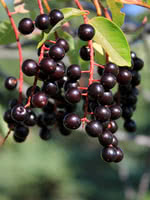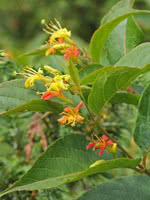Mon-Fri 9am - 5pm Mountain time
Western Chokecherry vs Northern Bush Honeysuckle
Prunus virginiana var. demissa
Diervilla lonicera
NOT AVAILABLE THIS SEASON - MIGHT RETURN
Western Chokecherry is a shrub or small tree commonly used for farmstead and field windbreaks.
It produces white flowers in the spring and edible dark purple fruit that matures between September and October. Its cherries are great for making for making jams, jellies or wine, but are not very palatable for raw eating.
The Northern Bush Honeysuckle is a small, dense, deciduous shrub. The trumpet-like yellow flowers bloom late spring to early summer. Dark green leaves turn yellow then red in the fall. The flower nectar has a sweet honey taste that can be sucked out of the flower.
Because of its aggressive suckering habit, the Northern Bush Honeysuckle makes a great hedge, shrub border, or thicket in a woodland garden.
Western Chokecherry Quick Facts
Northern Bush Honeysuckle Quick Facts
Toxicity: toxic to horses, cattle, etc.)

